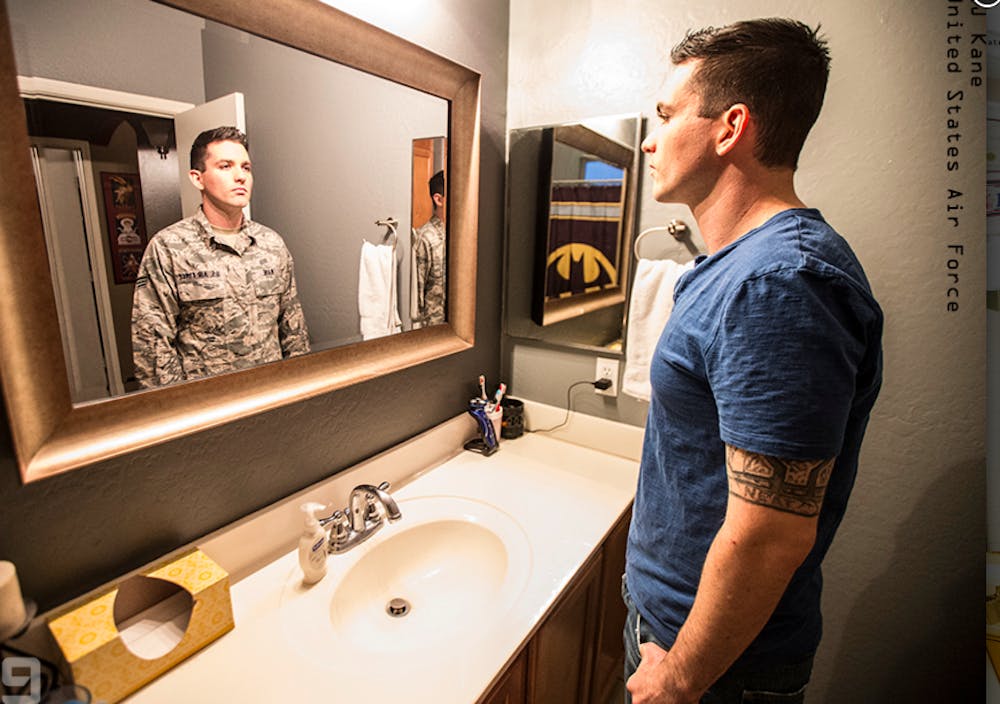Devin Mitchell, ASU online student and photographer, woke up on a September morning in 2014 to a viral flood of responses to a photo he had posted the night before.
When he opened up his computer after posting the photo on his personal Facebook page, it had acquired over 2000 likes and 1000 shares.
The photo, “Photo 13,” portrayed Marine veteran Brad Ivanchan, whom had lost both legs in combat, looking at a reflection of his self dressed in military uniform.
Throughout the ASU Salute Service week, Mitchell’s work will be showcased on all four campuses. Mitchell was commissioned by ASU to photograph veteran faculty, staff, students, and alumni who registered to participate.
Over the next year after the initial images were taken, it would soon be known as the “Veteran Vision Project,” in which Mitchell would take over two hundred more photographs portraying the effects of war on a person.
After the photo went viral, he received numerous emails asking if he was the photographer responsible for the photo.
“There was a wave coming and I had the opportunity to see where that wave might take me,” says Mitchell.
Mitchell says that it was not even a project at the time. “It didn’t even have its own Facebook account,” he says.
Between now and then, Mitchell has gained national attention for his work, resulting in opportunities to speak at various universities and even appearing on “CBS This Morning.”
“He’s not a veteran and yet he’s bringing diverse images, realities and responses of so many veterans to the attention of both the military and civilian communities,” says Nancy Dallett, assistant director of the ASU Tillman Veteran's Center.
“He’s an important force in giving veterans a chance to reveal their stories of transition and reintegration," she says.
Before this project, Mitchell got his start in fashion and editorial photography. However, he discovered later in his career how important veteran humanitarianism was to him.
Mitchell says he did not have very much knowledge about veterans. “I didn’t even understand what defined the word ‘veteran’.”
Mitchell specializes in trick photography, creating optical illusions in his photographs. Mitchell decided to use this skill when he was assigned a project focusing on military veterans in one of his classes.
In August 2014, Mitchell took the first photograph. The photo was of Navy veteran Ricky Ryba, and Mitchell says that’s where it started.
“When Ryba’s friends saw his photo, they wanted one, then their friends wanted one and so on,” says Mitchell. “It really snowballed into this entire body of work that took a life of its own.”
Mitchell acknowledges that veterans are skeptical about letting civilians come into their homes and photograph them.
“Some of them are excited and some of them are in a lot of distress,” he says.
Mitchell says, for the most part, they are happy that he is there. “I think that’s the reason why I feel that this work is important,” he says. “It’s not just photography anymore."
Even though Mitchell is not a medically trained doctor, he knows he is providing some type of therapy to veterans.
“It’s an alternative form of healing,” says Mitchell. “It’s a way of expressing (themselves) and a way to bring the community (of veterans) together.”
Moving forward, Mitchell doesn’t plan to partner up with any other photographers. “I don’t really require any assistance because logistically it is so streamlined,” Mitchell says.
Mitchell plans to continue this work into the far future. “My goal is 10,000 photos,” he says.
“I imagine this will open up other doors that will need my attention,” Mitchell says. “I hope this becomes one of the many things I do.”




